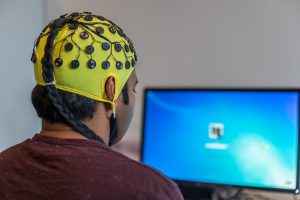SPIRIT TECH: THE BRAVE NEW WORLD OF TECHNOLOGY-ASSISTED SPIRITUALITY
In 2017, best-selling author Jonathan Robinson explained his, well, let’s say innovative, approach to spirituality: “I like playing mad scientist. You know, you try one thing and see what effect it has on you… and it’s exciting because we haven’t had these tools before. You know if you were born a hundred years ago, you were given one tool: you either pray to Jesus or you do Buddhist meditation. And now everybody gets to play mad scientists, and what you have to realize is that different people need different things. You have to find what works for you. It’s not a one-size-fits-all world anymore. You know, we have personalized medicine, and now we need personalized meditation and personalized spiritual technologies that will get us to the next place. So it’s a really exciting time for people who are willing to experiment.”
Robinson is describing an approach to spirituality that is becoming increasingly popular in the nearly twenty or so years since what the President George H. W. Bush designated “the decade of the brain.” This is the topic of a forthcoming book by CMAC researchers Dr. Wesley Wildman and Kate Stockly called Spirit Tech: The Brave New World of Technology-Assisted Spirituality, which is expected to hit the market in 2020.
Wildman, the founder and executive director of CMAC, and Stockly, one of CMAC’s doctoral fellows, explain that whether we welcome it or fear it, the era in which we can induce, prevent, and effectively control many kinds of spiritual behaviors, beliefs, and experiences is upon us.
With the development of improved brain imaging technologies has come a rapidly advancing understanding of and public interest in the way the brain works and the way the brain is drawn into dramatic altered states of consciousness.
From psychedelic tourism to techno-geek psychonauts, spiritual seeking has finally merged with high-tech entrepreneurism. Most people are still not aware of these technologies of spirituality, let alone how they are likely to develop over the next few decades. Spirit Tech introduces and evaluates, from the perspective of two scholars who have decades of research on religion and spirituality behind them, several new spiritual technologies within what they call the “scattered supermarket of special spiritual services.”
The first eight chapters of the book profile the technologies, weaving together research on the history, contemporary use, and health and safety of each technology with interviews conducted with both experts in each field and ordinary people who have used the technologies to enhance their own spiritual lives. These chapters are bursting with stories of personal transformations and spiritual growth that sometimes seem more the stuff of religious testimonials than of reports on technological innovation.

Spirit Tech looks specifically at brain-based technologies, including neurofeedback-guided meditation practices, transcranial magnetic stimulation applied toward the development of paranormal skills, church services held in virtual reality (accessible only with a virtual reality headset), contemporary manifestations of the use of psychedelic substances for spiritual growth, and even technology for brain-to-brain communication that may enable groups to drum up a high degree of collective fervor. But as they explain, these exciting developments are only the tip of the iceberg when it comes to the future of spirit tech.
Wildman and Stockly spend the last three chapters exploring some common questions and concerns that arise when people or their loved ones begin dabbling in spirit tech. Will these technologies induce authentic experience and give me reliable information about spiritual realities? Can they make me a better person? Can they be safely incorporated into my existing spiritual life? How do they fit with my current religious beliefs?
Religious groups and spiritual seekers have always employed whatever means and methods were available in a culture at any certain moment. The diversification of musical instruments added new melodies to the ritualized shamanic drum beat, the printing press revolutionized people’s relationship to religious texts; when radio and TV emerged, it didn’t take long before preachers and spiritual gurus were recording and broadcasting their messages; now in the “information age,” people can “attend” church via an online live stream, they can tithe with a click of the button, and, as Wildman and Stockly discuss in chapter six, people can even get baptized and receive sacraments in Virtual Reality.
Spirit Tech explores the next and potentially most transformative revolution: the potential for a cyborg spirituality—in which brain-based technological advancements are harnessed and applied to enhance and facilitate spiritual experiences from achieving Nirvana to meeting God to communing telepathically with fellow believers. It is a brave new world, indeed!
For any inquiries or comments, please email admin@mindandculture.org.


